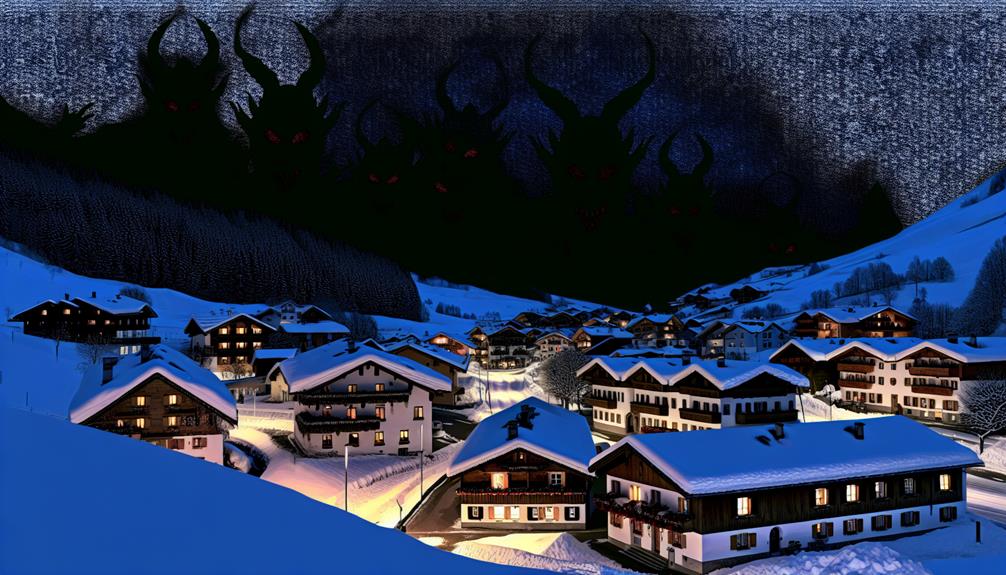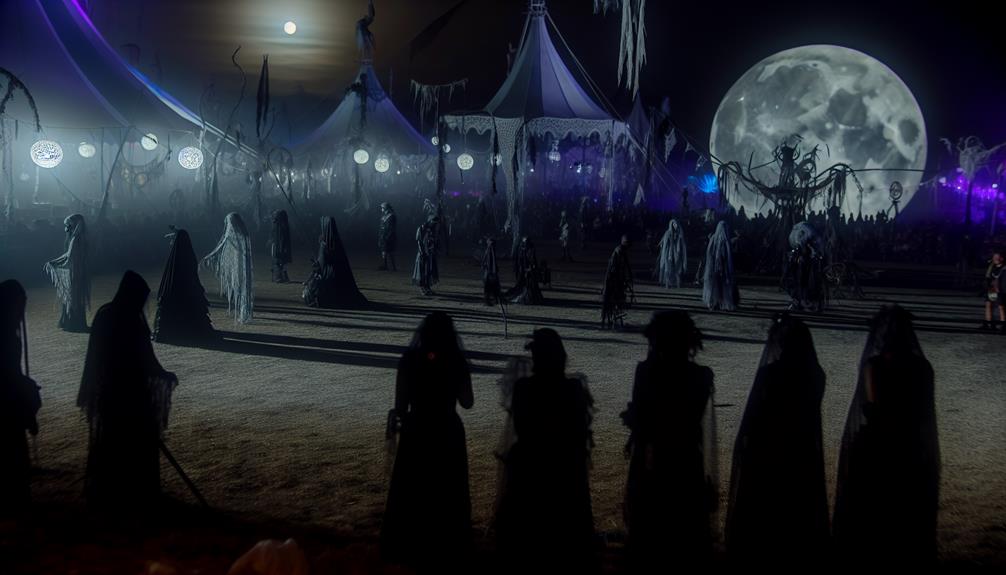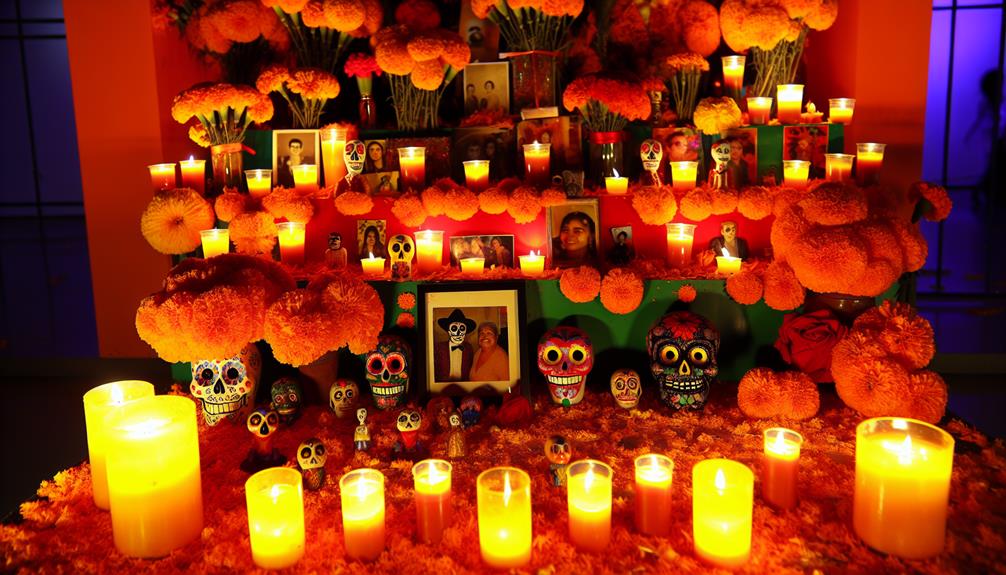The annual observance of Krampusnacht in Austria offers a fascinating intersection of folklore and contemporary culture, drawing curious onlookers into a world where tradition and modernity converge in a chilling display. As the dark counterpart to St. Nicholas, Krampus emerges on December 5th to deliver a cautionary tale in a manner that is both terrifying and enthralling. The Krampuslauf processions, with their intricate costumes and eerie masks, beckon spectators to witness a spectacle that explores the depths of Austrian heritage and the complexities of the holiday season. This haunting experience is not just a tradition; it is a portal to a world where myth and reality intertwine, leaving observers captivated and intrigued.
Key Takeaways
- Krampusnacht celebrated on December 5th in Austria.
- Krampus is a mythical creature punishing misbehaving children.
- Blend of Christian and pre-Christian traditions.
- Krampuslauf parades ward off evil spirits.
- Costumes and masks in parades blend tradition with modernity.
Origins of Krampusnacht
The origins of Krampusnacht can be traced back to ancient folklore and traditions in Alpine regions of Europe. Krampusnacht, which translates to Krampus Night, is a centuries-old tradition celebrated on the night of December 5th, preceding the feast of St. Nicholas in Austria and other parts of Central Europe. This event revolves around the mythical creature known as Krampus, a horned, anthropomorphic figure with roots in Germanic folklore and pagan beliefs.
In Alpine folklore, Krampus is depicted as a companion of St. Nicholas, who punishes children who have misbehaved while St. Nicholas rewards the well-behaved ones. The history of Krampusnacht intertwines Christian customs with pre-Christian traditions, blending elements of mythological creatures with the spirit of the holiday season.
The tradition of Krampusnacht has evolved over time, with elaborate parades and events held in various towns and cities across Austria. Participants don intricate Krampus costumes, complete with furs, masks, and chains, to embody the fearsome yet whimsical nature of this legendary creature. The festivities include Krampuslauf, or Krampus run, where these costumed figures roam the streets, delighting spectators and adding a touch of dark folklore to the Christmas season. Through the lens of folklore and mythological creatures, Krampusnacht continues to captivate audiences with its unique blend of tradition and spectacle.
The Legend of Krampus
Originating from centuries-old Alpine folklore and traditions, the legend of Krampus embodies a mythical creature intertwined with the spirit of the holiday season. In European holiday folklore, Krampus is known as a horned, anthropomorphic figure who punishes misbehaving children during the Christmas season, contrasting the benevolent figure of St. Nicholas. This mythological being is said to accompany St. Nicholas on his rounds, carrying chains and birch branches to swat naughty children and carry them away in his sack.
The Krampus mythology has deep roots in Germanic folklore and pagan traditions, possibly dating back to pre-Christian times when he may have been a horned god of the witches. Over the centuries, this figure evolved into the fearsome yet darkly whimsical character known today. The legend of Krampus serves as a cautionary tale, reminding children to be good and obedient, lest they face the consequences of Krampus' wrath.
In contemporary times, Krampus has experienced a resurgence in popularity, becoming a symbol of the counterculture against the commercialization of Christmas. The figure of Krampus continues to fascinate and intrigue people around the world, adding a touch of dark whimsy to the holiday season.
Krampusnacht Traditions and Customs
With roots in Alpine folklore and holiday traditions, Krampusnacht customs and traditions offer a unique insight into the darker side of the holiday season. The customs associated with Krampusnacht date back centuries and are deeply intertwined with traditional folklore traditions. Let's explore some of the key elements that make Krampusnacht such a distinctive and intriguing celebration.
| Tradition | Description | Purpose |
|---|---|---|
| Krampuslauf | Parades where individuals dress as Krampus | To ward off evil spirits and bring good luck |
| Birch Switches | Krampus carries bundles of switches to swat people | Symbolizes purification and the casting out of demons |
| Krampuslauf | Involves loud bells, chains, and frightening masks | To create a sense of fear and chaos |
Krampusnacht customs often involve a mix of fear and excitement, as participants embrace the darker aspects of the holiday season. The Krampuslauf, or Krampus run, is a central component of the festivities, where people dress up as Krampus and roam the streets, interacting with the crowd. The use of birch switches by Krampus symbolizes the cleansing of the old year and the preparation for the new one. Additionally, the loud bells, chains, and scary masks worn during the Krampuslauf aim to create a sense of chaos and fear, reminding individuals of the consequences of misbehavior. Overall, Krampusnacht traditions are a fascinating blend of ancient folklore and modern-day revelry, offering a unique glimpse into the rich cultural tapestry of Austria.
Costumes and Masks at Krampusnacht
Costumes and masks play a pivotal role in the visual spectacle of Krampusnacht, adding a sinister and enchanting dimension to the annual tradition. The creativity behind the costumes worn by participants at Krampusnacht is truly remarkable. Many individuals spend months preparing their outfits, aiming to strike the perfect balance between fear-inducing and visually stunning. From intricate handmade costumes to elaborate masks, every detail is carefully crafted to embody the spirit of Krampus.
Mask making is a revered art form associated with Krampusnacht. These masks are not just accessories; they are essential tools in bringing the mythical creatures to life. Craftsmen often use traditional techniques passed down through generations to create masks that are both terrifying and awe-inspiring. The process of making these masks involves intricate carving, painting, and decorating, resulting in pieces of art that are as unique as they are chilling.
The costume creativity seen at Krampusnacht is not limited to the Krampus figures alone. Attendees of the event also put effort into their attire, with many choosing to dress in traditional Alpine clothing or donning their own interpretations of demonic beings. This blend of traditional and modern elements adds depth to the visual tapestry of Krampusnacht, making it a truly immersive experience for all who participate.
Krampus Parades Across Austria
The grandeur of Krampusnacht extends beyond individual costume creations, manifesting in the form of Krampus parades that sweep across various regions in Austria each year. These parades are deeply rooted in Krampus folklore, a tradition that intertwines with Austrian celebrations. The parades serve as a tangible representation of the cultural significance and historical roots associated with the Krampus legend.
Austrian cities and towns come alive with the rhythmic sound of bells and the haunting sight of elaborately crafted Krampus costumes during these parades. The atmosphere is charged with excitement and a hint of fear as spectators line the streets to catch a glimpse of these mythical creatures in action. The parades often feature a mix of traditional folklore elements and modern interpretations, blending the old with the new in a mesmerizing display of Austrian heritage.
Participants in the Krampus parades showcase their creativity and craftsmanship through intricate masks, detailed costumes, and dramatic performances. The parades provide a platform for individuals to express themselves artistically while paying homage to centuries-old traditions. As the Krampus folklore continues to evolve, these parades serve as a dynamic reflection of how Austrian culture embraces its past while embracing innovation in the present day.
Krampuslauf: Running of the Krampus
During the Krampuslauf, also known as the Running of the Krampus, participants embody the menacing spirit of the folklore figure as they move through the streets with a blend of intensity and theatricality. This unique event is a significant aspect of the Krampus folklore, where individuals dress up as Krampus, complete with elaborate costumes, masks, and accessories, to engage in a race that showcases both athleticism and tradition. The Krampuslauf race is not just a physical challenge but a cultural representation that celebrates the darker side of the holiday season.
To provide a clearer understanding of the Krampuslauf race, the following table outlines key aspects of this event:
| Aspect | Description | Importance |
|---|---|---|
| Attire | Elaborate costumes, masks, and accessories | Reflects Krampus folklore |
| Route | Moving through streets with intensity | Adds theatricality to the race |
| Participants | Individuals embodying the spirit of Krampus | Essential for race dynamics |
| Cultural Significance | Celebrates the darker side of the holiday season | Preserves folklore traditions |
| Community Engagement | Draws spectators and participants alike | Strengthens cultural bonds |
The Krampuslauf race not only entertains but also serves as a platform for communities to come together, engage with tradition, and embrace the rich folklore surrounding Krampus.
Krampusnacht Festivities and Events
Embracing the ancient traditions of folklore and myth, Krampusnacht in Austria unfolds as a night of revelry and cultural significance. The festivities during Krampusnacht are marked by a variety of events and activities that captivate both locals and tourists alike. One of the main attractions is the Krampuslauf, where elaborately costumed Krampuses roam the streets, interacting with the crowd and spreading both fear and excitement.
Krampusnacht events often include parades featuring not only Krampuses but also St. Nicholases, angels, and other mythical characters. These parades are accompanied by traditional music, creating a lively atmosphere that immerses participants in the spirit of the celebration. Additionally, various competitions and performances take place throughout the evening, showcasing the talents of local artists and entertainers.
Festive activities during Krampusnacht go beyond the parades and performances. Markets selling traditional crafts, food, and drinks pop up, offering attendees a chance to indulge in local delicacies and shop for unique souvenirs. Bonfires are also a common sight during the festivities, adding a warm glow to the wintry night and providing a cozy spot for gathering and socializing.
The Dark Side of St. Nicholas
Obscured within the historical narrative of St. Nicholas lies a lesser-known aspect that explores the world of darkness and folklore. While St. Nicholas is widely recognized for his benevolent nature and association with gift-giving, there is a contrasting portrayal that delves into the domain of dark folklore and holiday traditions.
To shed light on this intriguing contrast, let's explore a comparison between the traditional image of St. Nicholas and the darker folklore surrounding him:
| Traditional St. Nicholas | Dark Folklore | Holiday Traditions |
|---|---|---|
| Kind-hearted and generous figure | Sinister companion such as Krampus | Unique customs and celebrations |
| Brings gifts to children who have been good | Punishes misbehaving children | Blend of joy and fear during festivities |
| Associated with Christmas and joy | Linked to tales of punishment and retribution | Reflects the duality of human nature |
| Symbol of hope and goodwill | Symbolizes consequences for wrongdoing | Adds depth and complexity to holiday narratives |
| Inspires acts of kindness and charity | Inspires caution and reflection | Sparks conversations about morality and ethics |
This juxtaposition between the traditional portrayal of St. Nicholas and the darker folklore surrounding him provides a fascinating insight into the multifaceted nature of holiday traditions. It invites us to explore the complexities of human behavior, the interplay between light and darkness, and the enduring appeal of folklore in shaping cultural beliefs and practices.
Krampusnacht: A Haunting Experience
The concept of Krampusnacht in Austria emerges as a chilling counterpart to the traditional benevolence associated with St. Nicholas, embodying a stark contrast that explores the darker domains of folklore and holiday customs. This haunting folklore is deeply entrenched in Austrian culture, where Krampus, a demonic figure, is said to accompany St. Nicholas on the evening of December 5th, the night before St. Nicholas Day.
During Krampusnacht, participants dressed as Krampus roam the streets, embodying the spirit of this menacing figure through elaborate costumes featuring horns, fangs, and chains. The atmosphere is filled with an eerie energy as these creatures interact with spectators, often playfully scaring them as part of the cultural celebration.
The roots of Krampusnacht can be traced back to pre-Christian traditions in the Alpine region, where the figure of Krampus was believed to punish children who misbehaved, contrasting sharply with the reward-giving St. Nicholas. This juxtaposition of good and evil adds a layer of complexity to the holiday season, inviting individuals to confront the duality of human nature and the consequences of their actions.
In modern times, Krampusnacht has evolved into a popular event that attracts both locals and tourists, offering a unique and spine-chilling experience that explores the macabre side of holiday festivities.
Frequently Asked Questions
Are Children Actually Scared During Krampusnacht?
Children may experience fear during cultural events like Krampusnacht due to the psychological impact of childhood fears and the influence of folklore traditions. These traditions often involve characters and rituals that can be intimidating to young individuals.
It is important to recognize that cultural practices vary, and what may be perceived as frightening in one context could be seen as a valuable part of tradition in another.
How Do Locals Prepare for Krampusnacht?
Locals prepare for the event by upholding traditional customs passed down through generations.
Festive costumes are meticulously crafted, embodying intricate details and symbols significant to the celebration.
Careful attention is paid to honoring the historical roots of the event, ensuring authenticity and cultural richness.
Through these preparations, communities come together to create a visually stunning and immersive experience that immerses participants in the spirit of the tradition.
Are There Age Restrictions for Participating in Krampusnacht Activities?
Age restrictions for participating in cultural activities like Krampusnacht are commonly influenced by cultural norms and traditions. These limitations are often in place to guarantee that participants are able to handle the fear-inducing aspects of the event.
What Is the Significance of the Krampusnacht Bonfires?
Bonfire traditions hold significant cultural importance across various societies worldwide. These rituals often symbolize renewal, purification, and community bonding.
In many cultures, bonfires are associated with ancient traditions, religious ceremonies, or seasonal celebrations. The act of gathering around a bonfire fosters a sense of unity and shared experience among participants, reinforcing social ties and fostering a collective connection to tradition and heritage.
Are There Any Modern Twists to the Traditional Krampusnacht Celebrations?
In the domain of folklore and tradition, modern interpretations often breathe new life into age-old celebrations. Cultural influences play a significant role in shaping how traditional festivities evolve over time.
As society progresses, various twists and adaptations emerge in the way we commemorate historical events. These contemporary changes offer a fresh perspective on the past, blending tradition with innovation to keep customs relevant and engaging for today's audiences.
Conclusion
To sum up, Krampusnacht in Austria offers a unique blend of ancient folklore and modern revelry, showcasing the dark side of the holiday season.
The traditions and customs surrounding Krampusnacht provide a haunting experience for both participants and spectators.
As we explore the origins and legends of Krampus, one cannot help but wonder: what other cultural traditions await discovery in the tapestry of Austrian folklore?


